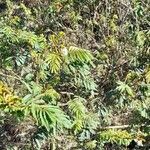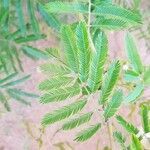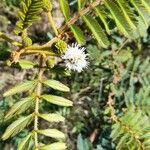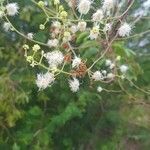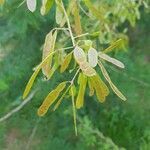Shrubs, deciduous, 3-6 m tall. Branchlets unarmed in distal parts, in lower parts armed by recurved prickles to 1 cm, densely yellow tomentose. Pinnae 4-9 pairs, 1.5-8 cm; rachis unarmed, pubescent; leaflets 12-16 pairs, linear, 5-7 × 1-1.5 mm, leathery, glabrous to puberulent with ciliate margin, main vein near upper side, apex mucronate. Heads globose, forming a spreading panicle with compound, spreading lower branches. Flowers white, scented. Calyx cup-shaped, minute. Petals oblong, 2.5-4 mm, connate at base. Stamens 8; filaments 4-5 mm. Ovary initially glabrous. Legume brown, straight, strap-shaped, 3.5-4.5 × ca. 0.6 cm, unarmed, finely reticulate veined, usually with 4-8 segments. Seeds olivaceous, ovoid, compressed, ca. 4.5 mm. 2n = 26*.
Leaves unarmed, petiole 0·3-1·7 cm. long; rhachis 1·3-9·5 cm. long, with 3-9 pairs of pinnae; leaflets 10-30 pairs (the lowest pair very reduced, ± equal, subulate), 4-12 x 0·8-2·6 mm., linear-oblong, venation basal and pinnate, prominent beneath; margins ± ciliate, not setulose.
Flowers whitish, in subglobose pedunculate heads 0·7-1·7 cm. in diam., clustered 1-4 together along the leafless branches of a terminal panicle; clusters leafless or with pinnate bracts up to c. 3 mm. long.
Shrub or small tree up to 10 m. high; stems varying from densely pubescent or puberulous to almost glabrous, and also ± sparsely armed with scattered straight or slightly recurved prickles 2-10 mm. long.
Pods brown, 2-6 x 0·5-0·7 cm., without bristles or prickles, glabrous or almost so, breaking up transversely into segments c. 5-7 mm. long, the margins persisting as an empty frame.
Corolla c. 1·5-2·5 mm. long.
Calyx 0·3-0·5 mm. long.
Stamens 8(10).
